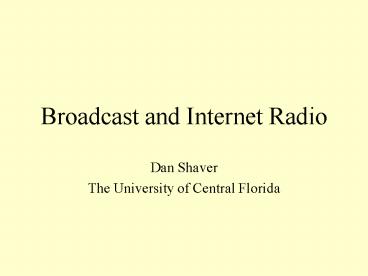Broadcast and Internet Radio - PowerPoint PPT Presentation
1 / 21
Title:
Broadcast and Internet Radio
Description:
Broadcast and Internet Radio. Dan Shaver. The University of Central Florida. What Happens When... Significantly more Internet-only stations (t=3.456, df ... – PowerPoint PPT presentation
Number of Views:165
Avg rating:3.0/5.0
Title: Broadcast and Internet Radio
1
Broadcast and Internet Radio
- Dan Shaver
- The University of Central Florida
2
What Happens When...
- New Technologies and Old Industries Collide?
- What competitive advantages do broadcast and
streaming audio have that may influence consumer
behavior? - What factors are likely to shape industry
evolution?
3
A Little History...
- Streaming Audio in the 1990s
- Simulcasting Without a Business Plan
- Small Audiences
- Sound Quality
- Bandwidth Issues
- Limited Accessibility
- Resistance to Subscription Fees
4
By the End of the 1990s...
- Product Enhancements
- Quality Reaches FM Standard
- Dedicated Streaming Audio Devices Introduced
- Wireless Delivery of Content to Cars
- AOL, Yahoo! and Viacom See Opportunities and
Begin Purchasing Services
5
By the End of the 1990s...
- Arbitron and MeasureCast (Now Nielsen) Begin
Measuring Traffic for Advertisers - Technology Available to Insert Customized
Information (Advertising, News, Weather, etc.) to
Individual Listeners
6
Then In 2002...
- The Recording Industry Strikes
- Demands Royalties for Broadcast Music
- Seeks Record-Keeping Requirements to Support
Royalty Payments - Wins in the Courts and the Matter Goes to the
Librarian of Congress - AOL and Yahoo! Reach Quick, Big Buck Settlements
- Many Stations Go Off-Line.
7
By August 2002...
- 20 of Americans Age 12 or Older Were Using
Streaming Audio or Video - 21 Had Residential Broadband
- Aggregate Streaming Hours Were Projected to Hit
275 Million Per Month by 2005. - 5 of Radio Advertising Dollars Were Projected
for Streaming Audio by 2005.
8
Trends...
- Top 50 Streaming Audio Sites (1/01 to 8/02)
- Steady Growth in Hours Streamed Despite Declining
Numbers of Stations - Differences Significant
- (t-5.166, df52.67, p
9
Trends...
- Stead Growth in the Number of Unique Listeners
- (t5.470, df52.053, p
10
Trends...
- Rapid Change in Top 50 Stations
- Only 3 from January 2001 made the August 2002
list - Formats in Top 50 diversified
- 12 to 17 Formats
- Significantly fewer college stations (t2.245,
df64.542, p.02) - Significantly more Internet-only stations
(t3.456, df94.83, p
11
Critical Broadcast/Streaming Competitive Issues
- Audience Adoption
- Barriers to entry
- Regulation
- Interactivity
- Market structure
- Programming strategies
12
Adoption
- Rogers
- Relative advantage
- Compatibility
- Complexity
- Requires
- Access to simple, devoted streaming audio
appliances - Delivery systems
13
Barriers To Entry
- Streaming Audio
- Minimum Investment
- Transmitters and Towers
- Engineering Staff
- No Spectrum Limits
14
Regulation
- Streaming Audio
- No Licenses/Fees
- No Compliance Requirements
- Royalty Fees for Recorded Music
15
Interactivity
- Potential differentiating characteristic
- Dependent on bandwidth
- Enable video, chat and commercial applications
16
Market Structure
- Broadcast
- Geographic and demographic
- Largely dependent on local advertisers
- Streaming Audio
- Demographic and psychographic
- Can assemble larger, world-wide audience
- Unclear who the advertisers might be
17
Programming Strategy
- Broadcast
- Ownership consolidation has fostered clustering
and format rationalization - Streaming Audio
- Potential for large, even more segmented audience
development - Economies of scale from originating multiple
world-wide formats from a single location
18
Implications
- Adoption issues imply that the potential for
direct competition between broadcast and Internet
streamers for audience and advertisers is not in
the immediate future but may become possible.
Meanwhile, they may serve complementary
audiences. - Reduced barriers to entry mean the streaming
audio market could become extremely competitive.
19
Implications
- Royalty issues mean music formats are likely to
be dominated by music producers (e.g., Virgin
Radio) or by deep pockets (e.g., AOL). - The lack of licensing and regulatory requirements
opens the door for innovative programming/content
strategies by online broadcasters.
20
Implications
- Although in its infancy, streaming audio is
already dominated by a small collection of
broadcasters. Five companies owned for 45 of the
top 50 sites in August 2002. - AOL (29 sites)
- MusicMatch (9 sites)
- Virgin Radio (3 sites)
- ABC Radio (2 sites)
- Educational Media (2 sites)
21
Implications
- If direct competition emerges--direct or through
simulcasting--the ability to leverage the
capabilities for interaction and customization
will likely be the key determinants of
competitive advantage.































